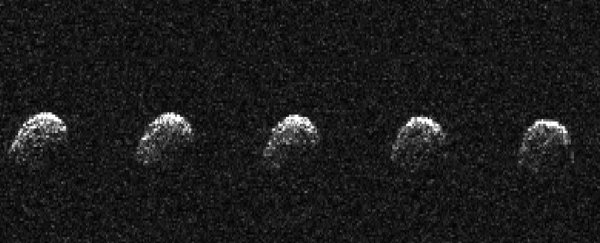A larger-than-usual asteroid is due to make a flying visit past Earth next week, on December 11.
It's called 4660 Nereus, a relatively frequent visitor to near-Earth space, which means it's been well characterized, with a diameter of 330 meters (1,083 feet). That's a little bit smaller than the height of the Empire State Building.
Despite the sensationalized tabloid headlines, 4660 Nereus is going to skim by at a nice, safe distance of 3.93 million kilometers (2.44 million miles) – just over 10 times the distance between Earth and the Moon.
Because of its size and distance from Earth, 4660 Nereus is classified as a potentially hazardous object. That classification includes any asteroid that will pass within 7.48 million kilometers (4.65 million miles) of Earth's orbit, and is larger than about 140 meters (500 feet) across. There are a lot of rocks that fall into that category.
There are many reasons for tracking them. These include making sure that they haven't deviated off their known orbits onto a trajectory more dangerous to Earth, and keeping an eye on groups of asteroids to maintain an awareness of what's moving through near-Earth space.
4660 Nereus, first discovered in 1982, is special – not because it is dangerous, but because it flies by Earth with relative frequency. Its 1.82-year orbit around the Sun brings it near to us roughly every 10 years or so, although although in space terms 'near' is still 'a safe distance away'.
Because of this, the asteroid has been considered a target for asteroid missions, such as Hayabusa (which ultimately visited Itokawa instead).
Its close approach next week will be the closest 4660 Nereus will be in decades. Its next close visit will be on 14 February 2060, when it will fly by at a distance of approximately 1.2 million kilometers (over three times the distance between Earth and the Moon).
While the asteroid poses no threat, it's better to be prepared than not, since we know asteroids have significantly affected Earth in the past.
Space agencies are working on that. Just last week, a NASA spacecraft launched on a mission called the Double Asteroid Redirection Test or DART, to try and ram an asteroid to knock it off-course. That encounter is due to take place in September of next year.
So you can rest easy that, of all the things you have to worry about, asteroids landing on your head is not currently one of them. And if you're really worried, you can keep an eye on upcoming asteroid close approaches here and here.
